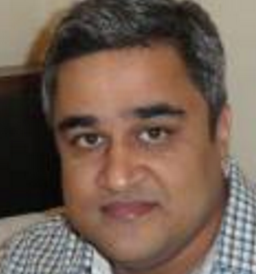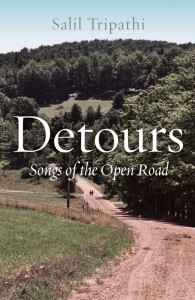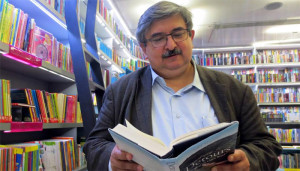Karthik Venkatesh on Granthika, a digital tool
 Karthik Venkatesh, a publisher, who often writes longreads on different aspects of publishing. He published an article in The Hindu on Granthika . It was heavily edited. Later he reposted the longer version on his Facebook wall. I am c&p the text here with his permission.
Karthik Venkatesh, a publisher, who often writes longreads on different aspects of publishing. He published an article in The Hindu on Granthika . It was heavily edited. Later he reposted the longer version on his Facebook wall. I am c&p the text here with his permission.
RK Narayan’s novel The Vendor of Sweets set as always in Malgudi is the story of Jagan, the sweetmeat vendor, his inner tussles between his Gandhian ideals and the pulls of his business that often leave him in a quandary and his imperfect relationship with his wayward son, Mali. Mali makes his way to America to join a creative writing course and returns a few years later, totally Americanized, with a Korean-American partner in tow. Back in Malgudi, Mali comes up with a grand money-making venture in the form of a story writing machine. It’s a machine in which would-be writers would only have to enter a few details like the number of pages, the number of characters, the place and time, the type of atmosphere and so on and the machines would churn out the story for them, or so goes Mali’s sales pitch.
The romantic image of the writer crouched over at the writing desk pouring his heart out on paper, with the several crumpled pieces of paper strewn around the room evidence of his hard work is one of literature’s most overworked images. It was this image perhaps that Mali sought to change. With Mali’s machine, churning out a story was a matter of pressing a few buttons. Mali’s story-writing machine is of course fictional, but to look at how writers have used technology to aid their writing endeavours is to come across several little nuggets of interesting information.
Historically, writing in longhand was the way most writers worked. Many like John le Carre still put pen to paper (the occasional writer like John Steinbeck swears by pencils), choosing to voluntarily forgo the mediating medium of the machine. A few lucky ones in the past had the benefit of a scribe (a la Veda Vyasa and Ganesha), but that couldn’t have been a cakewalk either. It required the writer to compose the piece in his mind and then regurgitate as the scribe put pen to paper or palm-leaf. The odd scribe is likely to have struggled to keep pace with the writer. But, arguably, more often than not, the scribe’s lot would have been to play the waiting game as the writer struggled to put it all together in his head.
And then, the typewriter came.
In 1874, Mark Twain purchased his first typewriter (a Remington) for $125. Seven years later, a typed manuscript of Twain’s Life on the Mississippi was sent to his publisher. Twain did not type it himself. In 1875, he had written to Remington to say that the machine corrupted his morals because it made him want to swear and so he gave the machine away, twice, only to have it return each time. Life on the Mississippi was dictated to a typist from a hand-written draft and was in all likelihood the first typewritten book. Among the typewriter’s other early adopters were Nietzsche and Henry James. Bram Stoker’s Dracula was also typewritten and its heroine, Mina Harker makes references to learning typewriting in the initial part of the novel. Clearly, the typewriter had arrived and for the next century or so, it was the writer’s machine of choice.
In the sixties, Jack Kerouac typed On the Road on a roll of paper which he had created by taping several together several sheets. What kind of paper it was is unclear. Among the possibilities are regular paper, a thermo-fax roll and sheets of architect’s paper. He did so because he thought the job of changing the paper would interrupt him and ‘thrust him back into the world’s inauthenticity’. Two weeks after starting On the Road, he had a single single-spaced paragraph a hundred and twenty feet in length all ready. The typewriter had played a critical role in birthing a classic.
The famously acerbic Truman Capote heard about Kerouac’s unusual ways and cuttingly remarked, “That’s not writing, that’s typing.”
And then came the word-processor.
Who was the Mark Twain of the word processor? There are several claimants most of them small-time with the exception of sci-fi writer Frank Herbert of Dune fame. After Dune’s success in 1965, it is said that Herbert submitted drafts of his works to his literary agent on 8-inch floppy disks in the 1970s, but no evidence exists to confirm this. The New York Times of March 24, 1981 published a rather interesting report which detailed how Jimmy Carter had accidentally deleted several pages from his memoir by pressing the wrong keys on his word-processor.
Among the early adopters of the word processor was Stephen King so much so that in the January 1983 issue of Playboy, he actually published a story entitled … “The Word Processor”! Later republished as Word Processor of the Gods in King‘s 1985 collection Skeleton Crew, the story talks of a word processor that is actually capable of altering the past and in effect, the future and whose discovery changes the lot of a frustrated middle-aged writer. Apart from King, Tom Clancy was an early adopter too and his 1984 thriller The Hunt for Red October, is often cited as one of the earliest word-processed best sellers. Since then, writing (Capote would call it typing) on the computer has pretty much become the norm.
In the second or third quarter of 2018, writer Vikram Chandra of Sacred Games fame hopes to have a beta version ready of Granthika, a digital tool for writers. While its first version will be designed for fiction writers, in the long run, a version for non-fiction writers as well, which will add all the features necessary for that genre, such as footnotes and endnotes, citations, etc. is also planned. Eventually, the goal is to build specialized versions for domains like legal writing, journalism, corporate documentation, scientific publishing, etc.
Its website lists its many components (it calls them ‘Multiple Independent Tools’): ‘a spreadsheet to keep track of dates and events, and to calculate the ages of characters, index cards to visualize the structural outline of the document, a timeline – perhaps drawn on a wall – to visualize the relationship between events (and) a word processor that doesn’t organize any of the above’.
The problem that it seeks to solve is the problem of writers making mistakes in their text and be able to keep track of all the logistics in the text. Among the instances of mistakes it cites to make its case are from Sherlock Holmes—Dr. Watson’s travelling injury (shoulder to leg) and his changing first name (John to James)—and more recently, an oversight in The Prisoner of Azkaban.
Granthika is on the face of it, as cutting–edge as it gets. The creation of a writer who understands writing and coding, it might just become to the early 21st century writer what the typewriter was to the late 19th and the word processor to the late 20th. Like it or not, most writers are typing now and with Granthika, Mali, Twain and King have actually been fused together!
(C) Karthik Venkatesh
5 February 2018


